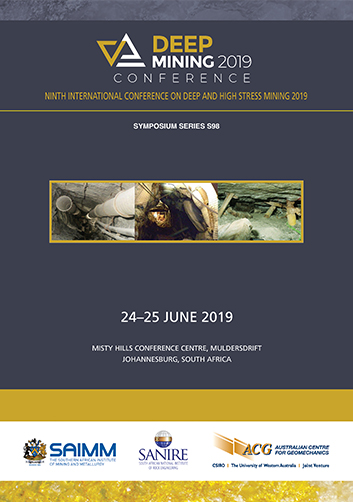The geotechnical evolution of deep level mechanised destress mining at South Deep

|
Authors: Andrews, PG; Butcher, RJ; Ekkerd, J |
DOI https://doi.org/10.36487/ACG_rep/1952_02_Andrews
Cite As:
Andrews, PG, Butcher, RJ & Ekkerd, J 2019, 'The geotechnical evolution of deep level mechanised destress mining at South Deep', in W Joughin (ed.), Deep Mining 2019: Proceedings of the Ninth International Conference on Deep and High Stress Mining, The Southern African Institute of Mining and Metallurgy, Johannesburg, pp. 15-28, https://doi.org/10.36487/ACG_rep/1952_02_Andrews
Abstract:
The South Deep mine is located approximately 45 km south-west of Johannesburg in the Far West Rand goldfield of the Witwatersrand Basin. It is a deep level mine that is actively mining between 2600 m and 3000 m below surface with expectations to mine to 3400 m depth. South Deep is situated in the geologically unique and renowned Witwatersrand Basin, which is the world’s premier gold region. The South Deep ore body gradually increases in thickness to the west, from approximately two metres at the sub-crop to approximately 120 metres in thickness. The geometry of the Upper Elsburg Reef package, which is the primary economic target, lends it to a fully mechanised mining method. The main geotechnical challenges to successfully mine the South Deep orebody were to introduce a mechanised massive mining method at depth to destress and then extract the extensive orebody. The destressing method then had to allow a productive method for economic extraction of an essentially low-grade bulk volume orebody. Several variations of different mining methods have been used to date but all rely on a destressing method to reduce the in situ stresses. Originally the destressing was done conventionally (traditional South African narrow reef gold mining methods). Since Gold Fields acquired South Deep in 2007, the push for further mechanisation has seen four mining method changes, including: mechanised, low profile, apparent dip destress mining; the introduction of a low profile, horizontal destress method with backfill. The year 2011 saw the introduction of low profile, horizontal destress with 2m wide crush pillars And in 2015, the mine moved to high profile (5.5m high) horizontal destress development with mechanised installation of ground support. Crush pillars were replaced with yield pillars.
References:
SRK. South Deep regional pillar optimization study (Stage II). Report 352262/2 to South Deep, dated February 2006.
SRK. Rock engineering assessment of proposed horizontal destress cuts and massive mining at South Deep. Report 396956/1 to South Deep, dated February 2009.
James, J.V., MacDonald, A.J. and Raffield, M.P. (1998). The backfilling philosophy for massive mining at depth in the South Deep Section, Western Areas Gold Mine. Proceedings of the Sixth International Symposium on Mining with Backfill. Bloss, M.L. (editor) Australasian Institute of Mining and Metallurgy.
Jager, A.J. and Ryder, J.A. (1999). A handbook on rock engineering practice for tabular hard rock mines. The Safety in Mines Research Advisory Committee (SIMRAC). Braamfontein, RSA.
Joughin, W.C, Bester, W.M, and Du Plooy, M. (2011). Mining methods and backfill at South Deep Gold Mine. Minefill 2011, International Conference on Mining with Backfill, The Southern African Institute of Mining and Metallurgy, 2011.
Watson, B.P., Pretorius, W., Mpunzi, P., Du Plooy, M., Matthysen, K., and Kuijpers, J.S. (2014). Design and positive financial impact of crush pillars on mechanised deep-level mining at South Deep Gold Mine. Journal of the Southern African Institute of Mining and Metallurgy, volume 114, n 10, Johannesburg October 2014.
Ozbay, M.U., Jager, A.J. and Ryder, J.A. (1995). The design of pillar systems as practised in shallow hard-rock tabular mine sin South Africa, The Southern African Institute of Mining and Metallurgy, January/February 1995.
© Copyright 2025, Australian Centre for Geomechanics (ACG), The University of Western Australia. All rights reserved.
View copyright/legal information
Please direct any queries or error reports to repository-acg@uwa.edu.au
View copyright/legal information
Please direct any queries or error reports to repository-acg@uwa.edu.au